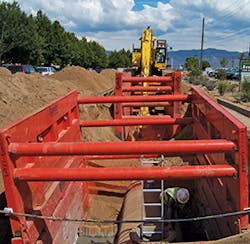Evaluating Trench Shield, Box, and Shoring Applications for Site Safety and Project Productivity
Shoring methods, trench shield materials-aluminum versus steel-as well as installation productivity are interlinked considerations at the excavation jobsite. In Part Two of his full-length feature on trench shield and excavation safety, author Daniel C. Brown explains why deeper excavations and OSHA soil-type factors might exceed a manufacturer’s recommendations and the productive applications of hooked trench box installations. Additional factors focused upon jobsite crew safety and project productivity are examined in greater detail along with slide rail shoring advantages in Brown’s article below.
A Life or Death Matter (Part 2) By Daniel C. Brown
Working to Depths
Michael Ross, national training director for Efficiency Production Inc. says the tabulated data for Efficiency Production’s hydraulic shores goes to 25 feet. Shores can only be set by hand to a relatively shallow depth, and if you go deeper, special tools are required to unhook the hydraulic equipment. “The trench shield becomes a more productive tool past 12 or 14 feet deep because it is much more forgiving at those depths,” says Ross. “You don’t have to place it and get unhooked from it once the box is in the ground. You just have to be able to get hold of it.
“Most of the shores you see working are at shallow depths, because that’s where they are most productive: less than about 10 or 12 feet,” says Ross. “They work in all depths up to 25 feet, but as a tool they’re most productive in depths up to about 12 feet. If you’re going to go very deep, you would have very tall shores. And your connection point would be near the top. You can set longer shores with a machine.”
We asked Ross about aluminum shields versus steel. “Your maximum depth and the weight are tied together,” Ross said. “The deeper you want to go, the heavier the box is going to get. So aluminum shields have a pretty good depth rating, but their depth rating is not as good as the same size box made with steel. But aluminum boxes are lighter and you can handle them with lighter machines, such as a backhoe loader. Your aluminum boxes are generally used in shallower depths and are matched to a machine that can dig to that depth.”
Soil Types
OSHA classifies soil into three simple types: A, B, and C. Type A soils are the best: clay, silty clay, and hardpan are examples. Type B soils are intermediate in stiffness-silt, sandy loam, clay, unstable dry rock. Type C soils are the least stable-gravel, loamy sand, soft clay, submerged soil, unstable rock, or soil in which water flows.
When manufacturers’ engineers write up their tabulated data recommending trench protection equipment for various depths and conditions, they further refine OSHA’s soil types. So manufacturers provide tabulated data for trench shields. The data will tell you the maximum depth not to exceed with a certain trench box, and most manufacturers will provide examples. “Don’t take this box any deeper than this depth in that type of soil,” says Ross.
A modular aluminum panel system is lowered into position.
Hydraulic shores work under a different principle. The tabulated data will tell you how far apart the hydraulic cylinders can be. “The deeper you get and the more unstable the soil becomes, you just have to put the hydraulic cylinders closer together,” says Ross.
Slide rail systems have vertical rails, and the sheeting slides down between the rails. “A slide rail comes into effect in situations where, for example, you’re setting in a lift station or a manhole,” says Ross. “You’ve got a four-sided system and four-sided boxes are not productive. They’re all hooked together, and you have to take them out all in one piece. So in a four-sided system, there are lots of reasons for the slide rail to become an advantage. Generally you can say that in poor soil conditions, slide rail systems are more productive than other methods such as driving sheeting, or beam-and-plate, or other older methods of shoring. You have to drive the sheeting with a crane, or some other method, and then you have to dig it out.
“But with a slide rail, you install that with an excavator,” says Ross. “It’s all one process. It might seem cumbersome and laborious, but as you’re digging, when you get to the bottom, you’re there. You’re ready to go to work. There’s no additional welding and fabricating, or bracing. It’s just one continuous system from the top to the bottom. Slide rail sheeting all goes down at one time-the rail and the sheeting. When you start, the posts are sticking up in the air, and as you dig down, you dig underneath the components and push them all down as a system.”



